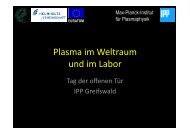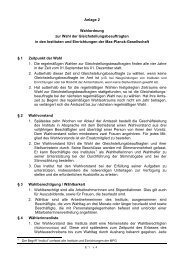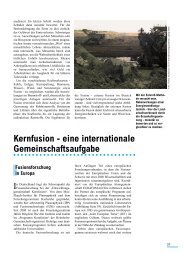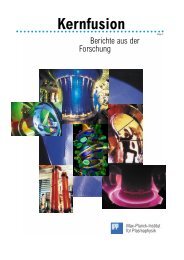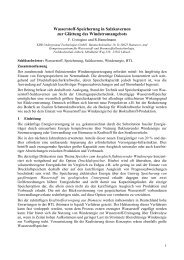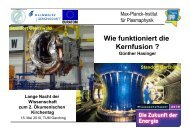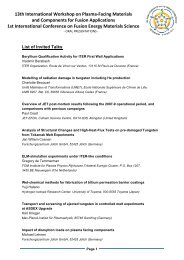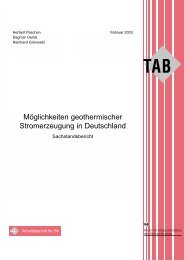IPP Annual Report 2007 - Max-Planck-Institut für Plasmaphysik ...
IPP Annual Report 2007 - Max-Planck-Institut für Plasmaphysik ...
IPP Annual Report 2007 - Max-Planck-Institut für Plasmaphysik ...
Create successful ePaper yourself
Turn your PDF publications into a flip-book with our unique Google optimized e-Paper software.
Since evaporation of cesium and the formation of Cs layers<br />
on metal surfaces play a key role in negative hydrogen ion<br />
sources, basic investigations on Cs behaviour in hydrogen<br />
plasmas have been started at the University in <strong>2007</strong>. To<br />
determine the thickness of a Cs layer, a specially designed<br />
quartz-crystal-microbalance is used that measures the frequency<br />
difference between two oscillating crystals. Figure 3<br />
(inlay) shows the measured correlation between Cs evaporation<br />
using a Cs dispenser at different currents and the<br />
change in frequency and thus the film thickness. In contrast<br />
to studies in high-purity conditions, the growth of Cs onto<br />
the examined surfaces (Cu, Mo, W, steel) is inhomogeneous;<br />
the cesium forms local, drop-like structures with a size of<br />
several μm. SEM pictures show that only 20-30 % of the<br />
metal is covered by those structures; consequently the measured<br />
thickness represents an effective thickness. In addition,<br />
a method for in-situ measurements of the work function<br />
using the photoelectrical effect (Fowler method) has been<br />
established. As shown in figure 3 the work function decreases<br />
with the Cs coverage of the molybdenum surface; however<br />
the work function does not fall below 2.8 eV towards the<br />
expected 2.2 eV for pure Cs.<br />
Work function [eV]<br />
4.4<br />
4.2<br />
4.0<br />
3.8<br />
3.6<br />
3.4<br />
3.2<br />
3.0<br />
2.8<br />
0.0<br />
Frequency change [Hz]<br />
600<br />
500<br />
400<br />
300<br />
200<br />
100<br />
Plasma Surface Interaction Studies<br />
0<br />
6.5A<br />
dispenser<br />
current<br />
7A 7.5A<br />
0 300 600 900 1200<br />
Dispenser on-time [s]<br />
0 10 20 30 40 50 60<br />
Effective cesium thickness [nm]<br />
Figure 3: Work function of a cesium layer on molybdenum as a function of<br />
the effective thickness. The inlay shows the thickness of the Cs layer during<br />
Cs evaporation using a dispenser.<br />
In strong collaboration with the materials research group at<br />
<strong>IPP</strong>, the ongoing work on chemical erosion of different<br />
doped carbon materials in low pressure ICP hydrogen and<br />
deuterium plasmas has now been focused on the one hand on<br />
the effect of the dopant distribution, i.e. carbide grain size<br />
and on the other hand on manufacturing and surface temperature<br />
effects on the erosion yield (released carbon particles<br />
per incident ion). Doping of carbon leads to a reduction of<br />
the effective carbon surface and thus to a reduced erosion<br />
University of Augsburg<br />
60<br />
50<br />
40<br />
30<br />
20<br />
10<br />
0<br />
Cesium thickness [nm]<br />
108<br />
yield in hydrogen plasmas. In-situ measurements of the fluence<br />
resolved erosion yield were carried out by optical<br />
emission spectroscopy (CH and C 2 band emission) in combination<br />
with weight loss measurements and RBS measurements.<br />
The incident ion flux towards the surface was measured<br />
using an energy resolved mass spectrometer in combination<br />
with a Langmuir probe. The effect of the dopant distribution<br />
was studied with amorphous carbon layers with atomically<br />
disperse distribution and different concentrations of the<br />
dopant materials (V, Ti, W). Another set of these samples<br />
was previously annealed at up to 1100 K leading to the formation<br />
of carbide grains with a size of several nm depending<br />
on dopant material and concentration. Figure 4 shows the<br />
results for vanadium doped samples with a surface temperature<br />
of 300 K and incident ion energy of 30 eV in deuterium<br />
plasmas. The solid line represents the erosion yield of undoped<br />
amorphous carbon. The yields show a strong decrease<br />
with the fluence and depend strongly on the dopant concentration.<br />
This strong reduction of the erosion yield can be<br />
explained by a surface enrichment of the dopant material<br />
which was proven by RBS measurements at the <strong>IPP</strong>. The<br />
pre-annealed samples always show significantly higher<br />
yields compared to samples without annealing; an effect<br />
which is less pronounced for titanium doped layers due to a<br />
less effective grain formation by annealing.<br />
Erosion yield G C /G ion [%]<br />
10<br />
1<br />
8.5%V<br />
Scientific Staff<br />
8.5%V<br />
pre-annealed<br />
1.5%V<br />
3.5%V<br />
Dopant: V<br />
3.5%V<br />
pre-annealed<br />
a-C<br />
1.5%V<br />
pre-annealed<br />
0.1<br />
0.0 0.5 1.0 1.5 2.0<br />
Fluence [1024 m-2 ]<br />
Figure 4: Erosion yields of vanadium doped amorphous carbon with atomically<br />
disperse dopant distribution and nm-sized carbide grains (preannealed)<br />
considering different concentrations of the dopant in ICP discharges<br />
with deuterium<br />
U. Fantz, P. Starke, S. Dietrich, S. Briefi, J. Ebad-Allah,<br />
D. Filimonov, S. König, A. Manhard, P. Schmidt.<br />
Energy scenarios group: J. Herrmann, F. Botzenhart, B. Grotz,<br />
A. Hämmerle, T. Hartmann.




